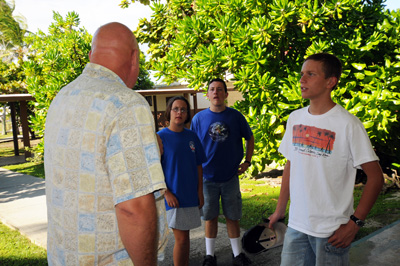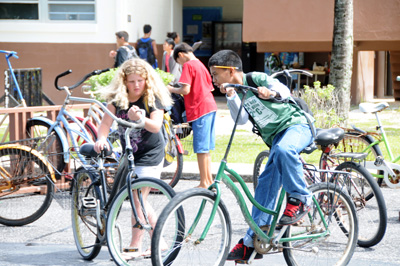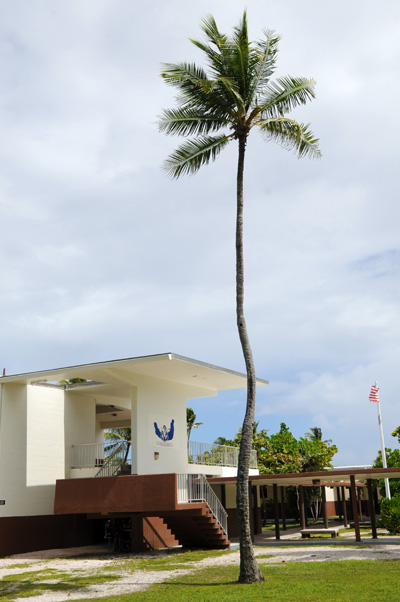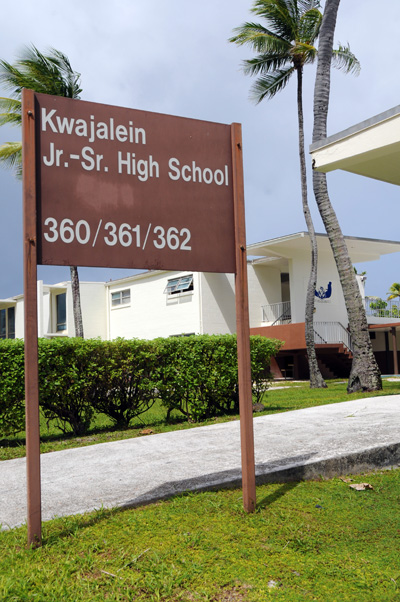By C. Todd Lopez
KWAJALEIN, Republic of the Marshall Islands (March 01, 2011) -- There's about one adult for every seven students at the schools on Kwajalein -- a ratio that trumps schools in nearly every category in the U.S., with the exception of special education.
Of course, there are less than 300 students between its two schools, which include George Seitz Elementary School and Kwajalein Junior-Senior High School. Class sizes average about 25 students -- about 25 will graduate high school in the spring and move on from island life.

The schools on Kwajalein, like nearly everything else on the island, are run by defense contractors -- they are not Department of Defense schools. But the small student body means teachers and faculty at the school can spend more time educating and preparing students for the future, and less time putting kids in the corner.
"We have high standards and virtually no discipline problems -- I've been here four years and we've never had a fight," said Al Robinson, the superintendent and principal of the Kwajalein schools. "We also enjoy, for the most part, really good parental support. When you peel away discipline issues, lack of parent involvement and lack of parent caring, you get down to where you can really teach kids 90 or 95 percent of your time."
When teachers can educate instead of dealing with those unrelated issues, the school can make great things happen for students, Robinson said.
"We tell our kids in seventh grade (that) when they get to the high school, if they do what they need to do and they work hard here, we can literally get them into any school they want to go to," Robinson added. "We've sent kids to any school you can imagine -- Ivy League schools and military academies."
A few years ago, for example, the valedictorian went off to Stanford, and this year's top student is headed to Johns Hopkins.
The small class size does make it hard for students to blend in or disappear.

"The people out here like it because it's more of a Family atmosphere," said senior Aaron Mathison. "You're close to your friends and you can be friends with anybody in school because you know who they are. In the States you blend in. If you don't want to be noticed for something, you're not noticed."
Mathison explained that it's a far cry from where he was back in the U.S., in Florida, where he had more than 300 kids in his class. "Most of the people walking down the hall you don't know and won't ever know," he said. "You only have a few friends, and you don't get along with everybody or you wouldn't hang out with them after school."
With a 3.9 grade point average, Mathison is applying to the Army, Navy and Coast Guard service academies.
He's not the only one headed off to the military, either. Two of his classmates are headed to the Army: Darryl Lorok and Robin Loeak. Both are Marshallese citizens who live on Ebeye, just north of Kwajalein. They've attended the American schools on Kwajalein since kindergarten as "rikatak" students. The Marshallese word means "guest."
Each year, five new Marshallese children from Ebeye are accepted into the American school system on Kwajalein, and are allowed to stay from kindergarten through 12th grade.
"They send 25 kids over from the preschools and kindergartens there and we screen them and look for things we think will make them successful -- we pick the top five," said Robinson. There are about 65 total slots for Marshallese in the Kwajalein school system -- about 20 percent of the student body.

Loeak likes to study physics and math in school, and plans to eventually serve as a behavioral health specialist in the Army after graduation. Lorok said he would serve as a generator mechanic.
"I chose to go to the Army because I thought it was an opportunity, a door that can be opened to a brighter future," Loeak explained. "There are a lot of benefits and financial help."
Both plan to use their access to the Army -- as Marshallese citizens with benefits under the Compact of Free Association with the U.S. -- to catapult themselves toward a better future.
"It'll be just four years until I'm eligible for the grants and the G.I. Bill so I can go to school," Lorok said. "I'm hoping to go in the Army for four years, then go to college after that to get a degree in political science. Then I'll come back to the Marshall Islands and help the Marshallese community."
Loeak is less certain of what he'll do after the Army, though.
"My first option is to try to go to college, and if college doesn't work out, a career in the military," he said. "I'd want to come back and help out here too, but I don't know. I still don't have my future planned."

Faculty members at the Kwajalein school are helping all the students craft plans for the future.
"My counselor is talking with the kids and trying to get them through the application process," Robinson said. "Some will go into military service, but all will be really qualified to go to junior college or any state school."
Robinson said there are challenges for students on Kwajalein. For one, the isolation means students are sometimes ill-prepared for the dangers and distractions of the larger world in the U.S.
"This is an incredibly safe place," he said. "A female athlete can go running at 2:30 a.m. by herself and never worry. It can be pitch black and nobody cares -- nobody will bother you. You won't be harassed or molested. So it's incredibly safe, probably too safe. It gives our kids a naive picture of safety."
Mathison said a friend of his, who has since left for school in New York City, has found it tough to adjust to his new surroundings.
"If you live out here you don't see the everyday situations you do in the States," he said. "A few of the kids that have grown up here and they go to college, they get really homesick. One of my best friends who graduated here two years ago is in college in Manhattan and always calls back and wants to know how people are doing -- he misses the island lifestyle. It's really different here."
The lack of modern technology at the school, especially access to the Internet, was also a problem in the past. But recent developments have made things better for educators and students.
"Until about a month ago all of our communications were bouncing off satellites," said Robinson. "So the amount of bandwidth that we had available to do public Internet sites was very small. It's a lot faster now because it's getting to the United States via Guam on an underwater cable. That's already made a huge difference" -- a difference that will further prepare Kwajalein's students for life beyond the island.